|
The
Pavilion of Indonesia, model shown here, will be a combination
of its country's sculpture, architecture, crafts, progress, food
and entertainment. The entrance gate, or Tjandi Bentar, will be
carved in stone in Indonesia to the specifications of authentic
Balinese temple entrances. The Meru (right), or temple tower,
will also be shipped from Indonesia to the exhibit site. The pavilion
has been designed by the Indonesian Architectural Committee, headed
by Mr. M. Sudarsono in association with Abel Sorensen and Max
O. Urbahn. The contractor is Turner Construction Co.
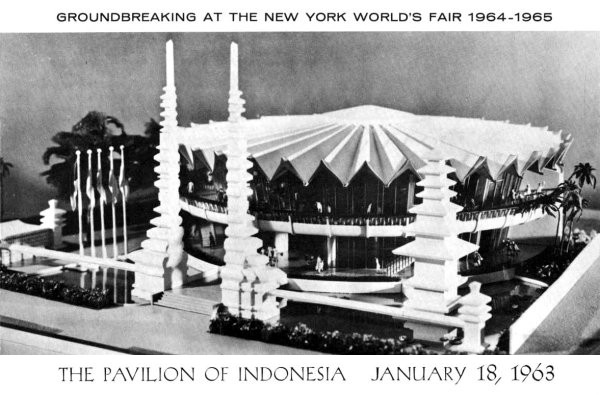 |
SOURCE: Groundbreaking
Brochure, The Indonesia Pavilion
|
Following is the transcription
of remarks by Indonesian and World's Fair officials at groundbreaking
ceremonies for the Indonesian Pavilion, New York World's Fair,
Friday, January 18, 1963.
RICHARD C. PATTERSON, JR. [Chief
of Protocol]: Your Highness, Your Excellencies, Mr. Moses, Mrs.
McCaffree and gentlemen. This groundbreaking is of very great
interest to the people of New York, the people of the United
States, of Indonesia, and the people of the world. It is symbolic
of the time in which we live. Indonesia - one of the largest
nations in the world in population, and I was told by his Highness,
coming out this morning, that it is now 96 million, in size and
in spirit - is many thousands of miles away from New York.
But President Sukarno, the founder
of this republic, came to the Fair on this site and he realized
what the New York World's Fair stands for - Peace through Understanding
- and man's achievements on a shrinking globe in an expanding
universe. He and his government, therefore, planned to bring
to New York and to the Fair, a part of Indonesia. The people
of New York, your Highness, and the world, will meet the people
of Indonesia here. They will learn of them - of their culture,
their history, and their plans for the future.
We are delighted that a part
of the Republic of Indonesia will be here in New York. It is
now my pleasure to introduce Mr. Allen Beach, director of the
International Area of the Fair. Mr. Beach has been working at
fairs a great part of his life. He has in fact, worked on fairs
in Indonesia. Mr. Beach.
ALLEN BEACH.: Thank you Ambassador
Patterson. Your Highness, your Excellencies, Mr. Moses, ladies
and gentlemen. Governor Poletti is traveling abroad. It would
have been very appropriate if he could have been here today,
and he would have liked to have been here because he was here
the day that President Sukarno came and was the host along with
Mr. Moses the day that he picked this site, So, on Governor Poletti's
behalf, I would like to say just a few words in welcoming you
here today.
Indonesia has a great story to
tell the world - a really very great story. It's a dynamic nation,
a determined nation, a forceful nation with youthful vitality.
By comparison to some other countries of the world, Indonesia
is a young country. It's a young republic, and it's on its way
to greatness. I have a very close affinity to Indonesia because
I have lived there, and the first fair that I worked on outside
of the United States was in Indonesia.
This was the Pekan-Raya International
in 1955, at Djakarta, a wonderful year to be in Indonesia, because
this was the 10th year of Indonesia's independence. The word
Merdeka - this is the word for independence and freedom - was
on everyone's lips as August 17th approached, the day of Indonesia's
independence. A tremendous ceremony was under way for weeks.
It was indeed a thrilling time to be in Djakarta and in Indonesia.
I recall how I was caught up
with the sprint of the ceremonies and the celebrations that were
going on, and many times I thought that this was probably the
feeling that my forefathers had many years ago in the United
States, when this country was a young country. Sri Sultan Hamengku
Buwonw is very representative of this forceful leadership in
Indonesia. He is here today as an emissary of President Sukarno,
and he - among his many duties - acquires a new duty which is
chairman of the Indonesian Committee for participation in the
New York World's Fair. He's a four star general. He heads up
all the tourist organizations of Indonesia, as well as his duties
as a Sultan of Djokjakarta. I think this is very representative
of Indonesia's leadership.
He was very instrumental in the
movement to bring independence to Indonesia, and was also instrumental
in negotiations that brought West Irian into the republic of
Indonesia. Indonesia is one of the first countries to break ground,
working with their architects - Abel Sorenson and Max O. Urbahn
and their construction company. President Sukarno is an engineer
and has taken a personal interest in the design and plan of the
pavilion.
I spent many wonderful months
in Indonesia. I visited many of your cities; enjoyed the friendship
of your people; enjoyed your culture; appreciated your art and
music; and now in 1964 and 1965, the many millions of people
who weren't as fortunate as I to travel to Indonesia will be
able, through your pavilion, to enjoy, appreciate and learn more
about your fine country.
|
His
Highness Sri Sultan Hamengku Buwono IX presents Fair President
Robert Moses with a native Indonesian wood carving.
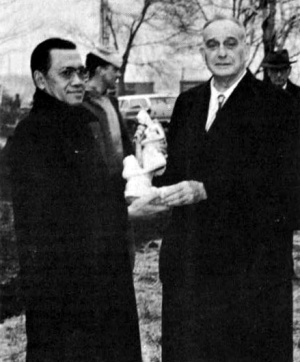 |
|
RICHARD C. PATTERSON, JR.: Thank
you very much, Mr. Beach. Your Highness, we are aware of the
great importance your government attaches to this Fair, and to
the representation of Indonesia, in that they have designated
a man of your stature and renown as its Commissioner General.
We are honored by your presence. We know that the Pavilion of
Indonesia will be one of the most interesting and exciting at
this Fair. Genelemen, I give you his Highness, the Sultan of
Djokjakarta.
HIS HIGHNESS SRI SULTAN HAMENGKU
BUWONO IX, COMMISSIONER GENERAL FOR THE PAVILION OF INDONESIA:
Honorable Mr. Moses, Commissioner Patterson, ladies and gentlemen.
As chairman of the Indonesian Committee for the New York World's
Fair, I wish to express my deep appreciation for your presence
at this gathering and your interest in this project. This groundbreaking
ceremony which marks the beginning of construction of the Indonesian
Pavilion at the World's Fair is evidence of the determination
of the Indonesian Government and its people to contributeto the
realization of the basic purpose of the Fair.
|
|
It is indeed the sincere hope
of the Indonesian nation that its participation in the Fair will
further the aims of world peace, develop better international
understanding, and promote harmonious international relations.
And, in this respect, I sincerely welcome and appreciate this
opportunity given to us by the New York World's Fair Corporation.
The Indonesian Pavilion which
will occupy a 40,000 sq. ft. block, will have a circular main
structure which will reflect our way of life; our rich and dynamic
culture; our huge natural resources and the possibilities of
exploiting them; and our contributions to world trade. And last,
but not least, it will reflect our efforts to attract foreign
tourists.
In this area we have seen the
emergence of many unique nations - each one struggling to develop
its own identity, and Indonesia, too, is still in the process
of consolidating the gains of its revolution. Quite logically,
the Indonesian Pavilion will illustrate the efforts which have
been made toward the realization of the aims of its revolution.
That is, the establishment of an Indonesian society based on
the five principles of our philosophy and the achievement of
friendly international relations through mutual respect and understanding.
|
|
The importance Indonesia attaches
to the World's Fair is indicated by the fact that President Sukarno
himself, before deciding on Indonesia's participation, viewed
the site of the Fair, and, furthermore, gave personal direction
in the planning of the pavilion. It has been decided by the Indonesian
Architectural Committee, in association with Mr. Abel Sorenson
and Mr. Max O. Urbahn, that the Indonesian Pavilion will have
a tropical accent. It has been conceived as an expression of
the rich culture and colorful history of our country, and of
the dynamic new developments which have occurred since independence.
The entrance gate which will exemplify our cultural past, will
lead to a pavilion depicting the present way of life of the almost
100 million Indonesian people.
A variety of Indonesian art goods
and handicrafts will be offered to the public at the gift shop
to the right of the entrance. the roof of the circular main structure
will bear a large sculpture reminiscent of a hand which will
symbolize the five inseparable principles of our philosophy,
the "Pancha Sila," emphasizing belief in God, humanitarianism,
national unity, democracy and social justice.
|
Robert
Moses presents and explains the Fair's official medallion to His
Highness, while Allen Beach looks on.
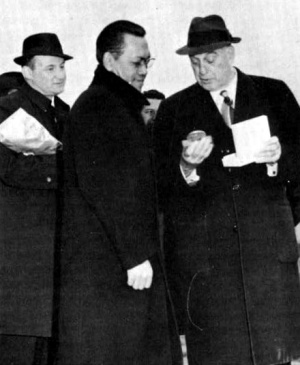 |
|
|
Indonesia is known for her great
scenic beauty, her various arts, her enchanting music, and her
variety of dancers - all these truly affecting her motto, Bhinneka
Tunggal Eka, or Unity through Diversity. But the people of Indonesia
are also known for their great hospitality and their skill with
exotic dishes, which we hope many visitors will sample at our
restaurant in the pavilion.
Since January 1961, Indonesia
has been doing her utmost to implement her 8-year overall development
plan. The success of the plan will not only enhance the standard
of living of the Indonesian people, but will also demonstrate
the benefits to the gained with technical and economic cooperation
between developing countries and highly developed ones. Let us
hope that the successful cooperation between the Indonesian Committee
for the World's Fair, and the management of the New York World's
Fair Corporation may be a happy omen of things to come. Not only
for my country, but for the entire world. Thank you. And may
I, on behalf of my government, give to Mr. Moses a symbol of
friendship.
ROBERT MOSES: Your Highness,
Mr. Ambassador, friends, we are happy to see you here again.
I remember with great pleasure the visit of your dynamic President
and his party in 1961, when you came to look us over. You are
here now as the Commissioner General of the Indonesian Pavilion.
I believe you like what you've seen. I'd like to add something,
not being much of a diplomat myself. I've seen a good many representatives
of foreign countries come and go in the last two years, and I
have seen no more interesting personality than President Sukarno's.
And I want to add something to
that also. He came out here and he looked the place over on the
ground. And he knew just what he wanted. He had a very clear
idea, being an engineer, of the size of the place. And then when
he got back, the lawyer said that they didn't quite have the
lease papers drawn up. They weren't ready. You remember that,
some of you. and he said he didn't care, that he'd sign his name
down on the bottom and they could fill out up above.
Now that's the kind of man I
like. Some years ago when I took over the building of the Power
Development on the St. Lawrence River, subsequently on the Niagara,
and that included a good part of the seaway, my officer in Canada
who had been the mayor of Toronto, Bob Saunders - who was later
unfortunately killed in a plane accident - came in and we talked
about a contract. And I said, why do we have a contract? Well,
they said, this is a billion dollar enterprise. I said, what
difference does that make? Let's do it on the basis of friendship
and getting along together. So we never had a contract. We carried
out that entire program, and I think this is quite unprecedented
in any kind of international affairs - with no contract at all.
We never had a dispute. And I think that President Sukarno is
just that kind of a fellow and the General is also.
|
| At this point we are building what
we consider to be an olympics of progress, which means that the
nations of the world, their industries, arts, inventions, will
be here in free and open competition to demonstrate achievement.
Indonesia is one of the great new countries of the world. I imagine
that there are very few people in the Untied States who have
any idea of what goes on there, aside from the fact that it is
stretched over about 3,000 miles as our country is - it
hasn't the same acreage or mileage, because the United States
has a greater latitude. And the Indonesians have a vague idea
of what it means to speak of a hundred million people. This is
a tremendous experiment in democracy, a great new republic, and
we are delight to have them here. We have a symbol of the Fair,
Your Highness. We want you to take it with you. It has the Unisphere
on one side, you saw that as we came here; that is, you saw the
beginning of work. On the other side is the shield of the City
of New York. And that's it. |
His
Highness Sri Sultan Hamengku Buwono IX and Robert Moses salute
the construction workers as they start excavation for the Pavilion
of Indonesia.
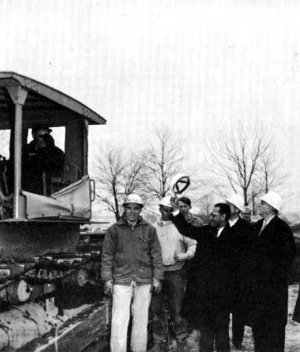 |
|
-
ARCHITECTURE OF THE INDONESIAN
-
PAVILION NEW YORK WORLD'S FAIR,
-
1964 - 1965
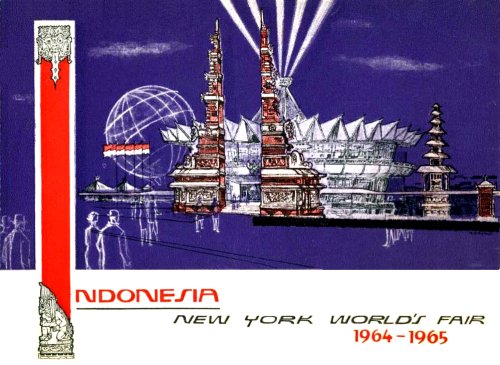 |
- To enter the Indonesian pavilion, one
has to go through a "Tjandi Benthar" gate. Before entering
the gate, one sees on the right side a "Meru" structure
and a lotus-filled pond.
-
- The "Tjandi Benthar" gate and
the "Meru" structure, which are specially Indonesian
forms of architecture and are well-known to tourists who have
visited Bali, are intended to take the visitor into an Indonesian
atmosphere.
-
- The reflection of the pavilion in the
pond may remind the visitor that Indonesia is a "watery
country" in the sense that the Indonesian and the Pacific
Ocean bound the country, while numerous seas and straits connect
its thousands of islands.
-
- The pavilion has a roof shaped like an
umbrella, a contrivance known all over Indonesia and used to
screen off the heavy downpour or the glaring sunlight which goes
with a tropical climate.
-
- The beams of the radial frame of the roof
converge at the axis and then spread out again the form of a
five-petal flower. From within the flower, five shafts of light
point skyward. The number five is symbolical of Pantja Sila,
the Five Principles on which the Republic of Indonesia is founded.
They are:
|
-
1. Belief in the One, Supreme
God
|
- 2. Humanity
|
|
- 3. Nationalism
|
|
|
SOURCE: Card, The
Architecture of the Indonesian Pavilion |
|